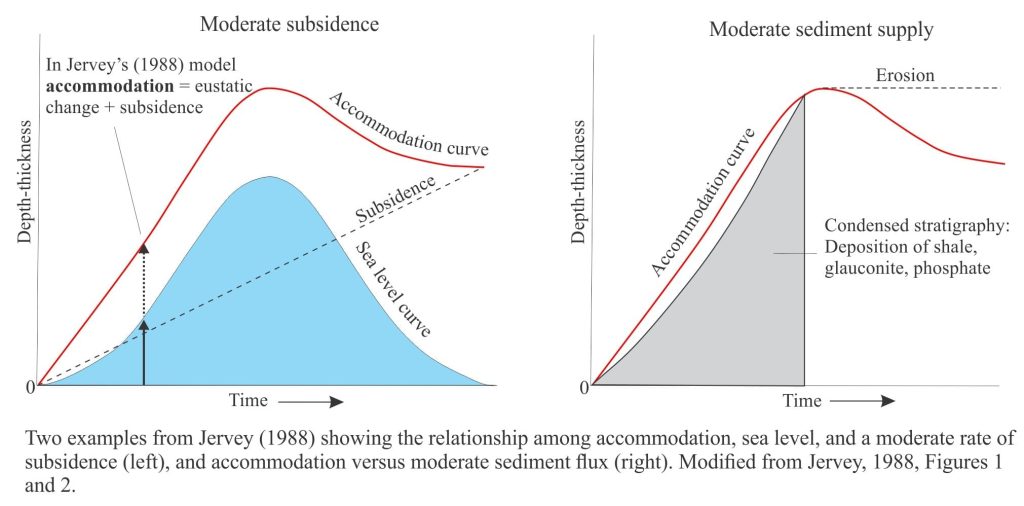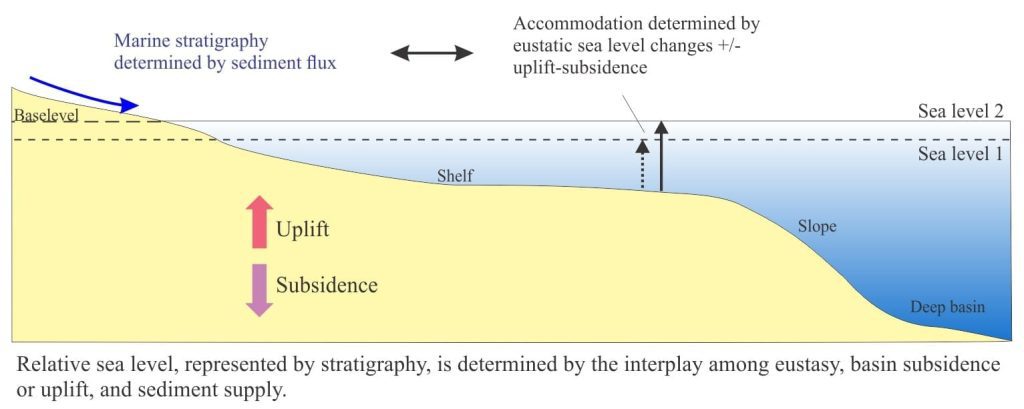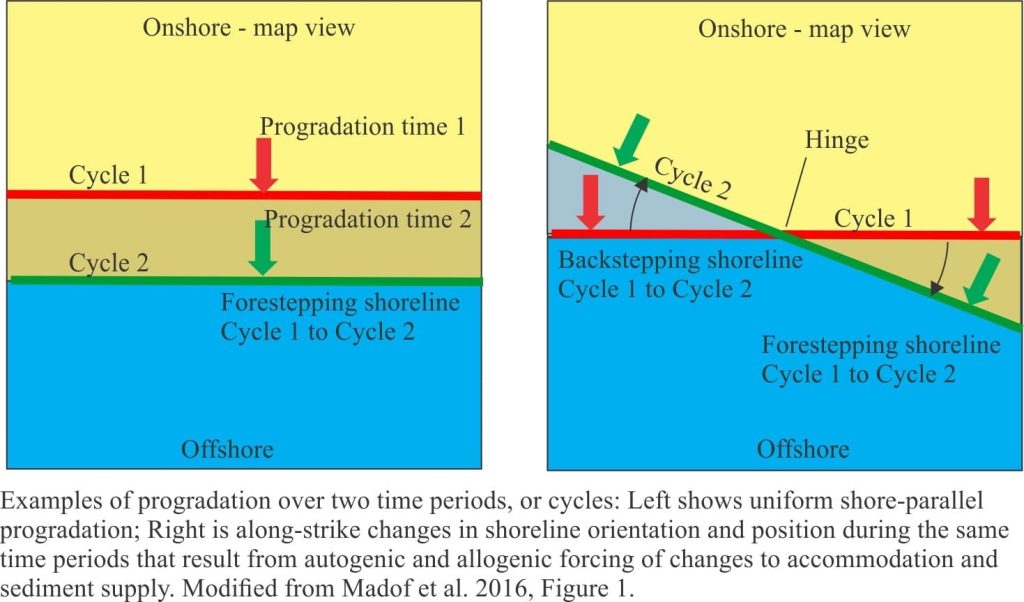

Spotted Eagle Rays grazing the lower boundary of available accommodation space, Cozumel. Courtesy of Charlie Kerans
The duality of stratigraphic accommodation and sediment supply
This is part of the How To…series on Stratigraphy and Sequence Stratigraphy
The literature on sequence stratigraphy commonly credits M. Jervey (1988) for introducing the concept of accommodation in the context of sediment deposition; his was also one of the earliest attempts to quantitatively model accommodation, sea level and sediment flux in the context of depositional systems and sequence boundaries. He was certainly one of the first to formalize the term, but the concept of depositional accommodation space has been around for at least 200 years. Lavoisier (in 1789) enunciated the role of sediment supply and deposition during rising and falling sea levels – a banner taken up by Lyell, Walther, Barrell, and Grabau. In every case, sea level fluctuations and sediment supply were accorded equal importance. But, as W. Schlager (1993) has noted, the early proponents of sequence stratigraphy challenged this duality (Vail, Mitchum and others), and determined eustatic sea level to be the prime mover of transgressions and regressions.
Jervey defined accommodation as the …”space available below base level (the level above which erosion will occur). On the continental margin, base level is controlled by sea level and, at first approximation, is equivalent to sea level”. The space available lies somewhere between sea level and the sea floor. Sediment supply is important in Jervey’s model but is considered in relation to accommodation space that varies only with sea level. Schlager’s (1993) paper focuses on the problems with this position.
Schlager developed the theme of dual control on the geometry of depositional systems tracts: the rate of change of accommodation (A), and the rate of sediment supply (S). He reminds us that high rates of sediment supply to depositional systems such as deltas and coastal plains, rates that are controlled primarily by geomorphology and climate, can outpace transgressions. We observe this in post-glacial drainage systems like the Himalayas (specifically the Ganges-Brahmaputra rivers), Mississippi delta, and the rapidly prograding Canterbury coastal plain (the eastern drainage system to the rapidly rising Southern Alps, New Zealand). Depositional systems like these can also supply large volumes of sediment to submarine fans during sea level rise; a counter to the early sequence stratigraphy mantra that base-of-slope and deep basin fan systems formed during sea level lowstands (most submarine fan systems are not limited by accommodation). Importantly, Schlager showed that stratigraphic stacking patterns in marine systems that are commonly attributed to accommodation, for example shoaling- or deepening-upward stratigraphic packages, can also be explained by changes in sediment supply. Schlager’s ideas are now incorporated into recent sequence stratigraphy models (Burgess, 2016, Catuneanu, 2009).
Debate about the value of A and S variables in sequence stratigraphy continued with two excellent papers by T. Muto and R. Steel (1997, 2000). They leveled two main criticisms at the idea that A versus S, otherwise stated as the A/S ratio, adequately explains observed stratigraphic stacking patterns and systems tract geometry:
- Sequence stratigraphy models did not, at that time, adequately describe lateral variations in either variable. For example, variations in thickness and stacking of contemporary units along depositional strike (i.e. constrained by the same timelines), means that A/S must also vary, even though the eustatic component of sea level rise or fall must have been the same at any of these locations. Such variations strike at the heart of what accommodation really means.
- There are dimensional problems with the ratio A/S because the two variables have different units – neither measure of volume (space) is easily quantified. One could simply refer to sea level change as a one-dimensional proxy for accommodation – in this case A is measured in dimensions of length, whereas S is a volume; Likewise, with Schlager’s definitions, A is a rate of change, and S a volume per unit of time.
Madof et al. (2016) have developed an instructive model of along-strike variability in stratigraphic stacking patterns. The model illustrates the fundamental difference between a strike-parallel prograding coastal system, and one where both autogenic controls (i.e. controls within the depositional system such as channel avulsion or delta lobe switching), and allogenic controls (e.g. tectonics, climate) force variations in accommodation space and sediment supply. The diagram below illustrates how such variations produce changing positions of shorelines and/or shelf-slope breaks (they refer to the latter as clinoform rollovers) over two cycles of relative sea level change and deposition. Here, the rate of progradation, and therefore shoreline migration, decreases towards a hinge. Continuing past the hinge, the shoreline actually retreats from cycle 1 to cycle 2. Therefore, the resulting stratigraphy will also change along strike, from stacking patterns indicating progradation (seaward), to contemporary patterns indicating retrogradation (landward).
The hinge location in this model will be static if there are no significant lateral shifts in allogenic controls. To complicate matters, hinge locations may also move laterally, and the example used by Madof et al. (2016) to illustrate this is from the Eocene Santos Basin (Brazil) where the locus of accommodation and deposition migrated in concert with source area uplift.
The principles and applications of accommodation and sediment supply are central to stratigraphic analysis. The supply-side is relatively straight forward. But accommodation, that is dependent on eustatic sea level fluctuations and basin subsidence, plus variable autogenic and allogenic processes along basin margins and source uplands, is anything but simple.
Thanks to Charlie Kerans (Geological Sciences, Jackson School of Geosciences, Austin, TX) for permission to use the header image.
Other posts in this series on stratigraphy and sequence stratigraphy
Stratigraphic surfaces in outcrop – baselevel fall
Stratigraphic surfaces in outcrop – baselevel rise
A timeline of stratigraphic principles; 15th to 18th C
A timeline of stratigraphic principles; 19th C to 1950
A timeline of stratigraphic principles; 1950-1977
Baselevel, Base-level, and Base level
Autogenic or allogenic dynamics in stratigraphy?
Stratigraphic cycles: What are they?
Sequence stratigraphic surfaces
Shorelines and shoreline trajectories
Stratigraphic trends and stacking patterns
Stratigraphic condensation – condensed sections
Depositional systems and systems tracts
Which sequence stratigraphic model is that?
Beach microcosms as analogues for fan deltas
References
P.M. Burgess, 2016. The future of the sequence stratigraphy paradigm: Dealing with a variable third dimension. Geology, v. 44 p. 335–336.
O. Catuneanu, et al. (28 authors) 2009. Towards the standardization of sequence stratigraphy. Earth-Science Reviews, v. 92, p. 1–33.
M.T. Jervey 1988. Quantitative geological modeling of siliciclastic rock sequences and their seismic expression. In: Sea-Level Changes – An Integrated Approach. C.K. Wilgus et al (Eds.), SEPM Special Publication 42, p. 47-69. Free to download
A.S. Madof, A.D. Harris, and S.D. Connell, 2016. Nearshore along-strike variability: Is the concept of the systems tract unhinged? Geology v. 44.
T. Muto, and R.J. Steel, 1997. Principles of regression and transgression: the nature of the interplay between accommodation and supply: Journal of Sedimentary Research, v. 67, p. 994–1000.
T. Muto and R.J. Steel, 2000. The accommodation concept in sequence stratigraphy: some dimensional problems and possible redefinition: Sedimentary Geology, v. 130, p. 1–10
W. Schlager, 1993. Accommodation and supply—A dual control on stratigraphic sequences: Sedimentary Geology, v. 86, p. 111–136



